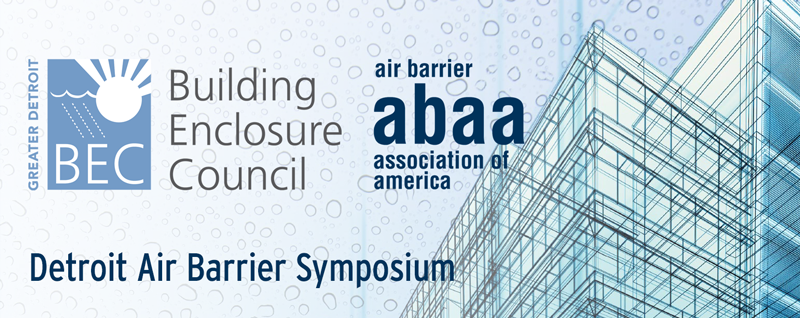
Date: May 08, 2019 | Time: 9:00am - 4:30pm - 6.5 AIA Health, Safety, Welfare (HSW) Credits
2019 DETROIT AIR BARRIER SYMPOSIUM
Join the Building Enclosure Council of Greater Detroit and the Air Barrier Association of America for a day of Air Barrier Learning.
RSVP HERE
-Lunch included with all ticket purchases-
Up to 6.5 hours of HSW (Health, Safety, Welfare) CEU Credits available
SCHEDULE
8:00am – 9:00am Registration, Vendor Tables*
9:00am – 10:30am Air Barrier Connections to Curtain Wall and Store Front | Andrew Dunlap, 1.5 HSW CEUs
10:30am – 11:00am Break, Vendor Tables*
11:00am – 12:00pm Performance Mock-Ups | Adam Ugliuzza, 1.0 HSW CEU
12:00pm – 1:00pm Lunch, Vendor Tables*
1:00pm – 2:30pm Field Testing of Various Air Barrier Materials | Ryan Dalgleish, 1.5 HSW CEUs
2:30pm – 3:00pm Break, Vendor Tables*
3:00pm – 4:00pm The interaction of the Air Barrier airtightness and the resistance to water penetration through Wall Cladding Systems, as seen by AAMA 508 and 509 Standards | Robert Jutras, 1.0 HSW CEU
*Vendor Tables’ Completed Game Card | 1.5 HSW CEUs (total)
PROGRAM DESCRIPTIONS + LEARNING OBJECTIVES
Air Barrier Connections to Curtain Wall and Store Front – 1.5 HSW CEU Credits
Course Description
Critical details that typically cause building performance related issues will be focused on one of the largest failures of building enclosures: wall to window connections specific to curtain wall systems and storefronts. A step by step look at each critical detail in regards to sequence of construction and the various connections to ensure airtight/watertight and thermally protected details. Real life photos and job conditions will bring the realities of the construction process to show typical errors found and how they can be addressed correctly.
Performance Mock-Ups – 1.0 HSW CEU Credit
Course Description
Today’ s building construction must overcome complex building materials, multi-layer construction / multiple trades, thinner construction, limited on-the-job training, higher expectations, schedule, and are generally cost sensitive. In the past, building systems were simpler with fewer layers, there were many master tradesman, apprentice training, with less building performance expectations.
One way to help ensure a successful project is to incorporate an onsite performance mock-up (PMU). Typically, projects will include aesthetic mock-ups (AMU) to verify color, texture, materials, etc. for final approval on the project. In most cases, AMUs can very easily be modified to become PMUs, such that many of the common building enclosure field testing procedures can be performed. This presentation will discuss the design of onsite PMUs and examples of water penetration testing, air leakage and adhesion testing that can be performed.
Testing procedures will include:
• ASTM E1186, Standard Practices for Air Leakage Site Detection in Building Envelopes and Air Barrier Systems, Section 4.2.1 Building Depressurization or Depressurization with Infrared Scanning Techniques
• ASTM E1186, Standard Practices for Air Leakage Site Detection in Building Envelopes and Air Barrier Systems, Section 4.2.2 Smoke Tracer in Conjunction with Building Pressurization or Depressurization
• ASTM E1186, Standard Practices for Air Leakage Site Detection in Building Envelopes and Air Barrier Systems, Section 4.2.6 Chamber Pressurization or De-pressurization in Conjunction with Smoke Tracers
• ASTM E1186, Standard Practices for Air Leakage Site Detection in Building Envelopes and Air Barrier Systems, Section 4.2.7 Chamber Depressurization in Conjunction with Leak Detection Liquid
• ASTM E1105, Standard Test Method for Field Determination of Water Penetration of Installed Exterior Windows, Skylights, Doors, and Curtain Walls, by Uniform or Cyclic Static Air Pressure Difference
• AAMA 501.1, Standard Test Method for Water Penetration of Windows, Curtain Walls and Doors using Dynamic Pressure
• AAMA 501.2, Quality Assurance and Diagnostic Water Leakage Field Check of In-stalled
• Storefronts, Curtain Walls, and Sloped Glazing Systems
• ASTM E783, Standard Test Method for Field Measurement of Air Leakage Through Exterior Windows and Doors
• ASTM D4541-09e1, Standard Test Method for Pull-Off Strength of Coatings Using Portable Adhesion Testers
• ASTM C1521, Standard Practice for Evaluating Adhesion of Installed Weatherproofing Sealant Joints
Field Testing of Various Air Barrier Materials – 1.5 HSW CEU Credits
Course Description
During the construction process, a variety of both quantitative, qualitative and visual inspection can be done on the air barrier assembly to confirm conformance to project specifications. A review of the key test methods used during the construction process and a demonstration of the type of testing equipment for both air leakage, adhesion and material specific test methods and what to look for each type of commercially available air barrier system being specified today.
The interaction of the Air Barrier airtightness and the resistance to water penetration through Wall Cladding Systems, as seen by AAMA 508 and 509 Standards – 1.0 HSW CEU Credit
Course Description
The importance of preventing water penetration into wall construction is well documented and is a key factor in providing durability of the built environment, by minimizing wall components deterioration.
There are two concepts of Wall Cladding Systems that aims at achieving this goal. These are:
1) Pressure Equalized Rain Screen Wall Cladding Systems;
2)Drained and Back Ventilated Rain Screen Wall Cladding Systems.
The American Architectural Manufacturer Association has developed two test methods that evaluate the performance of these rain screen wall cladding systems. The use of these procedures help in establishing correlations between the airtightness of a building wall, the venting capacity of the cladding system and its ability to prevent problems associated with water penetration.
The presentation will review:
• Pressure Equalized Rain Screen per AAMA
• Drained and Back Ventilated Rain Screen per AAMA
• Review of AAMA 508-14
• Review of AAMA 509-14
ABOUT THE PRESENTERS
 Andrew Dunlap
Andrew Dunlap
SmithGroup
Andrew Dunlap’s primary work experience is focused on the analysis and development of building enclosure systems including wall cladding assemblies, air/water barrier systems, roofing, skylights, fenestration systems, and waterproofing. Specializing in the energy and hygrothermal analysis of wall, fenestration, and roof systems; his work extends from evaluating existing buildings, investigating problem buildings, revitalizing historic structures, to the design and consultation of new and specialty facades.
Andrew received his Bachelor of Architecture, Bachelor of Science in Mathematics, and Master of Architecture degrees from the University of Detroit Mercy. He provides presentations to several industry organizations on a regular basis and is published in numerous industry periodicals and journals.
He is active in the design and construction community and currently holds positions within the following organizations:
• American Institute of Architects (AIA) – AIA Detroit Chapter Vice President
• Air Barrier Association of America (ABAA) – Board Member
• Air Barrier Association of America (ABAA) – Research Committee Co-Chair
• ASTM E 06.55 Performance of Building Enclosures – Subcommittee Secretary
• ASTM E 06.41Air Leakage and Ventilation Performance – Voting Member
• ASTM D 08 Roofing and Waterproofing – Member
• Building Enclosure Council Greater Detroit – Past Chair
• University of Detroit Mercy Architectural Engineering Board of Advisors
Andrew’s work focuses on providing energy efficient buildings and he regularly participates in the development and refinement of exterior enclosure designs to exceed energy related goals. Project responsibilities include the collection of detailed building information, investigation and analysis of existing conditions, computerized thermal analysis (WUFI, THERM, WINDOW and other specialized software packages), formulation of remediation options, preparation of construction documents for remediation, and construction contract administration including field observation and system testing. This work often includes performing field air and water tests as part of forensic investigations or used to validate installed conditions.
 Adam Ugliuzza
Adam Ugliuzza
Intertek
Adam brings 11 years of experience as an engineer. His most recent roles with Intertek have concentrated on building enclosure consulting / commissioning, forensic investigations, working on projects throughout the United States evaluating and designing residential, commercial and industrial enclosure assemblies in various climate zones including roofing, claddings, fenestrations and below grade waterproofing.
He also leads the Building Science Solutions Mid-Atlantic consulting group for Intertek’s Building and Construction division. Managerial duties include staff members in offices in the Mid-Atlantic region and Pittsburgh, PA. Consulting Engineering practice areas under Adam’s leadership includes building enclosure consulting/commissioning, forensic investigations, whole building airtightness testing and infrared thermography discipline areas. Apart from Intertek, Adam is an ABAA board member and is currently chair of the Terminations, Transitions and Flashing Task Group and co-chair of the Whole Building Airtightness Testing task group.
 Ryan Dalgleish, CSI
Ryan Dalgleish, CSI
Air Barrier Association of America
Ryan has been involved in the building envelope and building performance areas of construction in both the commercial and residential sectors for over 20 years.
Ryan is a trainer, facilitator and is actively involved in research, training development and delivery, certification management and helping industries increase their professionalism. Ryan acts in the position of Chief Operating Officer for the Air Barrier Association of America.
Ryan obtained credentials in Adult Education, Leadership and Organizational Excellence from the University of Manitoba and has been mentored and trained by some of the best building scientist’s in the world. Ryan is a certified Net Zero building instructor, teaches master builder courses to builders across the country and is a frequent speaker at various technical presentations dealing with the building enclosure to various building official associations, city departments, building enclosure councils and chapters of the American Institute of Architects, Construction Specifications Institute and a number of local home builder associations.
Ryan frequently publishes papers for design and construction magazines such as Journal of Building Enclosure and Design, Construct Canada, Interface, Coating Pro Magazine, Western Exterior and Spray Foam Professional to name a few.
 Robert Jutras
Robert Jutras
UL CLEB
Robert Jutras is a Principal Engineer for the Building Envelope Performance Group at UL LLC. He is a graduate of École Polytechnique, the engineering department of the University of Montréal, earning a Bachelor degree in mechanical engineering. He has devoted the last 32 years of his career to building components testing and evaluation as well as standard and code development. He actively participates at ASTM, CSA, AAMA, NFRC, ULC and IGMA. He is also a voting member of the standing committee for environmental separators (Part 5) of the Canadian building code. He is also the codes and standards director at CLEB a UL company located in Varennes, Québec.
